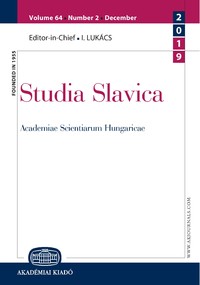Hromatska terminologija u rusinskom i srpskom jeziku
Chromatic Terminology in Ruthenian and Serbian
Author(s): Mihajlo P. FejsaSubject(s): South Slavic Languages
Published by: Akadémiai Kiadó
Keywords: chromatic terminology; Berlin–Kay’s theory; Ruthenian; Serbian; basic colours; colour shades; translation equivalents; Hungarisms; Germanisms; semantics
Summary/Abstract: In this paper, the author compares chromatic terms in Ruthenian and Serbian. He focuses on the basic colour terms according to Berlin and Kay: white, black, red, green, yellow, blue, brown, purple, pink, orange, and grey. They have equivalents in both languages: Ruthenian bila – Serbian bela, čarna – crna, červena – crvena, željena – zelena, žovta / žolta – žuta, belava – plava, braon – braon, lilova – ljubičasta, celova – roze, pomarančecova /poma- randžecova – narandžasta, šiva – siva. The criterion of one-morpheme word is not appli- cable to the terms lilova, celova, and pomarančecova /pomarandžecova in Ruthenian, and ljubičasta and narandžasta in Serbian. It is applicable to the terms bila, čarna, červena, željena, žovta / žolta, belava, braon, and šiva. With the exception of braon, all these terms are derived from the Proto-Slavic language (*bеlъ, *čьrnъ, *čьrvenъ, *zelenъ, *žltъ, *polvь, and *sivъ). As far as the Berlin–Kay’s universal of seven phases of colour formation is con- cerned, our study of chromatic terminology confirms it. In accordance with the supposed first stage of development, the Ruthenian language has bila and čarna; according to the second stage, Ruthenian has červena; in accordance with the third stage, Ruthenian has že- ljena or žovta / žolta; according to the fourth stage, Ruthenian has žovta / žolta or željena; in accordance with the fifth stage, Ruthenian has belava; according to the sixth stage, it has braon; and in accordance with the seventh stage (even if we leave aside the multi-mor- pheme terms lilova, celova, and pomarančecova /pomarandžecova), it has šiva. Generally speaking, the usage of the terms is identical in both investigated languages but there are several differences (e.g. cibulja – beli luk, željena pasulja – boranija). The most frequent suffixes are -asta and -ista in Ruthenian, and -asta in Serbian. Most of the chromatic terms are of Slavic origin but there are several borrowings used for nuance purposes in recent decades, e.g. azurna, teget, akvamarin, tirkizna, and others. Some borrowings remain unchanged, e.g. in both languages blond, braon, drap, krem, bež, and oker, and only in Serbian lila and roze. Hungarian was the official language until the first decades of the 20th century (until the collapse of the Austro-Hungarian Monarchy in 1918), during which Ruthenian–Hungarian bilingualism reigned. That is the reason why several Hungarian colour names are found, e.g. in surnames (the Ruthenian surname Barna comes from Hungarian barna ‘brown’, Fekete/Feketa is from fekete ‘black’, and Vereš is from vörös ‘red’) and in the names of domestic animals (the Ruthenian horse name pejka [Serbian riđan] comes from Hungarian pej ‘brown’ and šarga [Serbian žutalj] is from sár- ga ‘yellow’). The general name for ‘colour’ comes from the German language (Ruthenian farba is from German Farbe).
Journal: Studia Slavica Academiae Scientiarum Hungaricae
- Issue Year: 64/2019
- Issue No: 2
- Page Range: 309-320
- Page Count: 12
- Language: Serbian
- Content File-PDF

